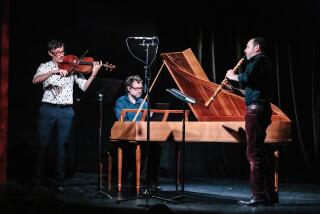Musicians Know the Rescore
It may not be written in stone, but almost everyone understands one of today’s critical strictures: “Thou shalt not transcribe.”
Leopold Stokowski’s once-popular orchestrations of Bach organ works, for instance, are now regarded as reflecting the taste of an earlier, less-sophisticated age than ours.
But what do we say when the composers decide to rescore one of their works?
The saintly Bach did it all the time. Even a 20th century luminary or two tweaked a previous work into another format, as American composer Samuel Barber did when he wrote a slow movement for his second string quartet in 1936.
Two years later, he arranged the movement for string orchestra. Everybody has heard “Adagio for Strings.” It was played ubiquitously as funeral music for presidents Franklin Delano Roosevelt and John F. Kennedy.
Nearly 30 years later, Barber arranged it for chorus and string orchestra. This version, “Agnus Dei,” John Alexander conducted Sunday in a three-part Barber and Bruckner program by the Pacific Chorale and the Pacific Symphony at the Orange County Performing Arts Center in Costa Mesa.
Are all three versions the same experience? Of course not. Are they equally valid? Certainly. The composer put all three out there for public consumption, and who has the right to second-guess him?
True, the 150-plus voices of the Pacific Chorale could not duplicate the justly famous string shivers at the work’s climax, but they did create a sound surprisingly weightless and yet oceanic as they responded to Alexander’s careful direction.
Barber (who lived from 1910 to 1981) was one of the few masters of setting English to a natural-sounding music. Yet his fine sense of text sensitivity surfaces mostly in the outer movements of his complex, four-part “Prayers of Kierkegaard,” which was next on the program.
The Danish philosopher’s texts are personal, private, humble, desirous of transcending the self. The music, while starting quietly in a wonderfully flexible English chant, by the third part grows huge, public and overblown, with words obscured in vocal counterpoint and by large orchestral declamations. It never quite recovers, even when it scales down in the final prayer.
The workmanlike soloists were soprano Carmen Pelton, contralto Ellen Rabiner and tenor Beau Palmer.
*
Bruckner’s Mass No. 3, which concluded the program, ranges from the austerity and intimacy of medieval religious art to earth-shaking visions anticipating the Atomic Age more than they reflect the 1860s when the work was composed.
The sense of intimacy was particularly well-served by the chorus’ hushed openings in several sections of the score and by the ever-warm, enveloping solos by Pacific concertmaster Raymond Kobler.
The composer’s portrayal of the titanic upheaval in the cosmic order that Christ’s resurrection effected was also sounded strongly and persuasively.
But much of the rest unfolded at an unvarying, wearying loud dynamic. Bruckner is one of the hardest composers to bring off. His climaxes must be differentiated. His contrasts must be exploited. His sense of structure must be intuited; it is not apparent. He cannot be conducted with unvarying tempos without paradoxically sounding longer than he is.
*
The key perhaps lies in seeing that he believed every word of the Mass. He set every line carefully, specifically and with devotion. A performance must respond in kind.
But Alexander seemed more concerned with keeping the music going and with exploiting the massive, rich, but homogenized sonorities of the chorale. As a result, too much of the score became a thick liquid flow, and critical words or phrases could not emerge with wonted impact.
Where Bruckner creates a sense of the personal (take away our sins), or the numinous (God of God, Light of Light) or the miraculous (God becoming man), the performance made little distinction. The volume was up or down. Even the great restatement that closes the Credo--the opening theme slowed down--sounded more perfunctory than conclusive.
Joining the hard-working, sometimes stressed “Kierkegaard” soloists was bass Ralph Cato.
More to Read
The biggest entertainment stories
Get our big stories about Hollywood, film, television, music, arts, culture and more right in your inbox as soon as they publish.
You may occasionally receive promotional content from the Los Angeles Times.










